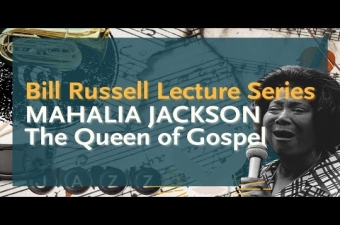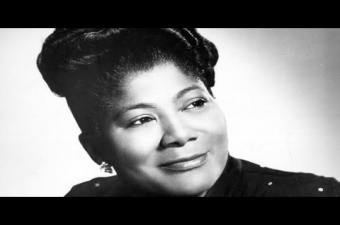Mahalia Jackson’s birthplace
Constance Street and Leake AvenueNew Orleans LA 70118
Mahalia Jackson was born here in 1911, in a house so close to the tracks at the base of the Mississippi River levee that it shook when trains passed. Throughout her reign as the “Queen of Gospel,” from the late 1940s until her death in 1972, she cited her upbringing here as foundational to her music and expressive performance style.
When Jackson was six years old, her mother died and she moved in with her aunt Duke, a few blocks away at 7456 Pitt Street, in a shotgun house a without indoor plumbing. Jackson was bowlegged as a child, which, biographer Mark Burford writes, “along with her poverty and parentlessness made her a sympathetic figure in the neighborhood.” But her aunt was an unforgiving taskmaster, and Halie, as Jackson was known, had to leave school to start earning money by the time she was ten or so.
Though she was allowed to do little more than work and go to church, Jackson grew up surrounded by music. There were produce vendors singing their sales pitches in the street, and men singing as they worked on the railroad tracks along the levee (Jackson said that, in her own singing as a child, she “put in the sadness” she heard in the workers’ voices).
She also heard jazz played by its pioneers, including Kid Ory, Joe Oliver, Bunk Johnson, and the Original Tuxedo Band, who advertised their gigs by playing on trucks that drove through the neighborhood. Then there were brass bands playing for funeral processions and parades sponsored by the benevolent societies she worked for as a secretary.
Jackson’s aunt forbade her from listening to blues records at home, but she soaked them up at church socials and as she passed neighbors’ houses and corner barrooms, which occasionally featured live music as well. Her favorite artist was Bessie Smith, who she managed to see in person at the Lyric Theater—Jackson would regularly draw comparisons to her when she started making records of her own.
Much of Jackson’s young life centered around Mount Moriah Baptist Church, where her grandfather, who was born into slavery on a plantation northwest of Baton Rouge, was a preacher. She was there every Wednesday and Friday, and all day Sunday, and performed in public for the first time as a member of the youth choir. The congregation was also a major influence on her musical sensibility, from its emotive style of singing hymns, to, as she put it, the “bounce” of its “foot-tapping and hand-clapping.”
While Jackson was a lifelong Baptist, she also drew inspiration from an old preacher at a Sanctified church down the street from her house:
…there was a way that he would preach [that] would have a singing tone in his voice that was sad and it does something to me. Really, it is the way that I sing today, from hearing the way the preacher would preach in a cry, in a moan, would shout sort of like in a chant way, a groaning sound, which would penetrate to my heart.
She carried the sounds of New Orleans with her to Chicago either in 1927, as most sources relate, or in 1931, as Burford argues. In any case, her powerful contralto, brimming with feeling, became an attraction in Black churches in the Windy City in the 30s. The “jazzy” physicality of her performances rankled some conservative churchgoers at first, but Jackson explained:
David said: “Make a joyful noise unto the Lord. Clap your hands and come before his presence with singing.” The Lord don’t like us to be dead. Be alive! If you feel like it, pat your feet. Sometime I don’t only pat my feet. I dance to the glory of God, because he said so. So that’s why we like these songs that got a bounce.
She gained popularity on the Black gospel circuit that grew in the period before World War II.
Later, with the success of her records, especially “Move On Up a Little Higher” in 1948, Jackson helped bring this music to the mainstream. In the 1950s Jackson’s profile grew with radio and television appearances and a multi-record deal with Columbia. Along the way she inspired a new generation of gospel singers, including Aretha Franklin and Mavis Staples.
Even as she joined the A-list and sang for heads of state, Jackson’s humble origins by the levee remained integral to her public persona and her self-conception. Sensitive to social injustice, she became a prominent voice in the civil rights movement. Along with her rejection of lucrative opportunities to turn from gospel to popular music, this earned her unmatched moral authority. In 1964, a Gallup poll named her one of the “Most Admired Women in the World.”
Today, a high-rise apartment building stands on this site, near the parking lot of the Audubon Zoo.
Videos

In "Mahalia Jackson: The Queen of Gospel Music" Dr. Mark Burford, Dr. Valerie Francis, and vocalist Andaiye Alimayu present lecture and music to celebrate Jackson’s extraordinary life and career.
Video by The Historic New Orleans Collection.
In "Mahalia Jackson: The Queen of Gospel Music" Dr. Mark Burford, Dr. Valerie Francis, and vocalist Andaiye Alimayu present lecture and music to celebrate Jackson’s extraordinary life and career.

"Mahalia Jackson: The Power and the Glory" documentary directed by Jeff Scheftel
Video posted by Kayla Williams.
"Mahalia Jackson: The Power and the Glory" documentary directed by Jeff Scheftel
Images

















